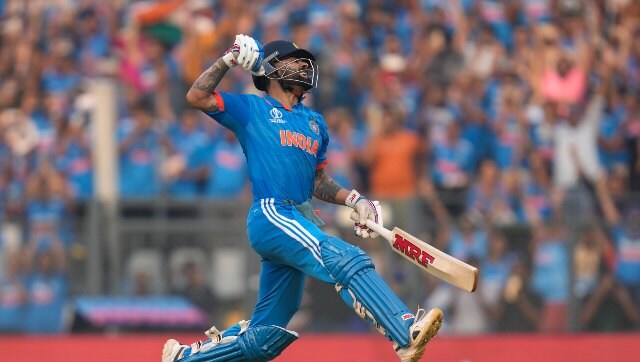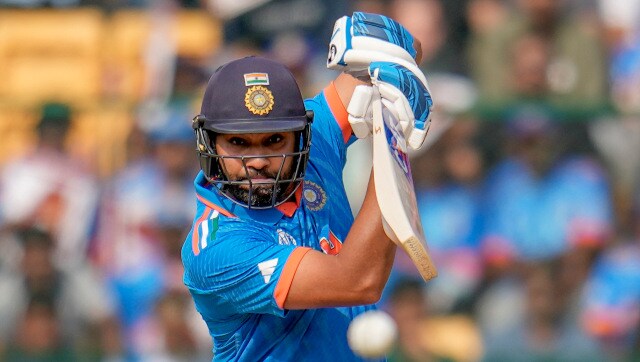World Cup 2023: Rohit Sharma’s India stumble in final hurdle after near-perfect campaign
World Cup 2023: Rohit Sharma’s India stumble in final hurdle after near-perfect campaign

India had a near-perfect campaign under Rohit Sharma’s inspiring leadership in the 2023 ICC World Cup, and still could not walk away with the glittering trophy in their hands on Sunday at Ahmedabad’s Narendra Modi Stadium.
World Cup 2023: News | Schedule | Results | Points table
The Men in Blue had not won an ICC event since MS Dhoni masterminded their triumph in the 2013 Champions Trophy in England, and there was genuine hope of the curse finally being lifted the way India were steamrolling one opposition after another for more than a month.
Cricket’s showpiece event had not witnessed a team dominate this way since Clive Lloyd’s West Indies in the first two editions and Ricky Ponting’s Aussies in 2003 and 2007. India weren’t just outclassing the other teams — they were beating them by record margins. Sri Lanka by 302 runs. South Africa by 243 runs.
The World Cup, however, isn’t a league-based tournament where one bad day doesn’t decide the fate of a team as far as its title ambitions are concerned. And no matter how solid the Indians were throughout the tournament, they ended up losing against an Australian team that not only was better in all departments on the day, but have mastered the art of bringing forth their ‘A’ game in the crunch games.
Read | India didn’t win World Cup, but Rohit Sharma’s blueprint is the way forward
Looking back at the events of the 13th editions of the ICC World Cup, we analyse everything that went right with the Indian team, along with an area or two where they were found lacking:
Rohit leads from the front as Indian batters flex their muscle
The defeat to Australia in Sunday’s final doesn’t take anything away from the fact that Rohit not only has been tactically astute a leader, but has also led from the front, finishing with 597 runs across the season at a superb average of 54.27.
Rohit wasn’t the only member of the Indian batting lineup in form in this World Cup — nearly everyone in the top six made an impact over the course of the event that lasted a little more than a month, with Shubman Gill and Suryakumar Yadav the only batter to not score centuries along the way.
Let’s not forget the fact that Rohit would have finished on the top spot for a second time in as many World Cups had it not been for Virat Kohli and his record-breaking run, amassing 765 runs at a Bradmanesque average of 95.62. Not only did he break Sachin Tendulkar’s record for most ODI tons, becoming the first to hit 50 of them in the format, he also broke the Master Blaster’s record for most runs scored in a single edition of the World Cup.

What made Rohit’s contributions standout from the others however, was the manner with which he took on the opposition bowlers in the powerplay, making the lives of those batting at lower positions all the easier. It was especially evident in the match against South Africa on a tricky Eden Gardens wicket where his 24-ball 40 helped India race to 91/1 at the end of the powerplay; the Proteas could manage just 83 in reply.
It was no different against the mighty Aussies on Sunday at what was a slow and low Motera wicket. Australia skipper Pat Cummins raised many an eyebrow with his decision to bowl first, a decision that would later be hailed as a masterstroke.

The manner in which Rohit took the attack to Mitchell Starc and Josh Hazlewood in the powerplay, however, would have had one wonder if Cummins’ call was indeed the right one and whether this pitch really was as difficult as experts had made it out to be. India raced to 80/2 thanks to Rohit’s efforts, but it was the slowdown over the next 40 overs, in which India could collect only four more boundaries, that further highlighted the ‘Hitman’s knock.
That things did not go according to plan in the summit clash doesn’t take the slightest bit of credit away from the Indian batters, with four of them finishing among the top-10 run-scorers, two of whom sit right at the top.
India’s collecting bowling might
It’s not just the batting department where India were outstanding. The Men in Blue also witnessed its pace trio of Mohammed Shami, Jasprit Bumrah and Mohammed Siraj along with spin twins Ravindra Jadeja and Kuldeep Yadav blow opposition batting lineups away throughout the course of the tournament. And nearly pull off something similar in the final.

Jadeja and Kuldeep, along with Ravichandran Ashwin, had been at the forefront of India’s six-wicket victory over Australia in their tournament opener in Chennai. Against Pakistan, it would be a complete performance where both spinners as well as seamers, including all-rounder Hardik Pandya, played a role in skittling the opposition out for a modest total. In both cases, two key teams had been bowled out for less than 200 that would later be easily overhauled by an in-form batting lineup.
Pandya’s exit from the World Cup due to an ankle injury suffered in the match against Bangladesh appeared a massive blow initially because of his utility both with bat in the middle order as well as with the ball in the middle overs. Instead, it would turn out to be a blessing as Shami, who had been benched in the first four matches, would finally get included in the XI and make an instant impact with a five-for against New Zealand.
Shami had impressive runs in 2015 and 2019, but it was in the 2023 edition where he was in the form of a lifetime and highlighted his stature as India’s man for the big events. And his inclusion would transform the pace unit into one that would single-handedly win matches.
Since Shami’s inclusion, India would bowl England, Sri Lanka and South Africa out for scores of 129, 55 and 83 respectively. While the spinners played a greater role in the victory over the Proteas with Ravindra Jadeja collecting a five-for, the bowling performances against England and Sri Lanka were thoroughly dominated by the pace department.
The last time India’s pace unit had been this lethal as a collective unit was in the 2018-19 Border-Gavaskar Trophy in Australia and in the 2021 Pataudi Trophy in England. And in a tournament that was expected to be dominated by the spin department, it was this pace trio that stole the limelight.
Where things went wrong
As disappointing as the defeat was in the final, one cannot point out too many shortcomings in this Indian team over the course of the World Cup campaign, which further highlights the fact that it was one bad day in the office that robbed them of their first ICC title in a decade.
One could point a finger towards Suryakumar Yadav not living up to his full potential in the World Cup after replacing Pandya at the No 6 position in the middle order. Barring a fighting innings of 49 off 47 deliveries on a tough Ekana wicket in Lucknow that helped India cross 200 against England, he didn’t make much of an impact with the bat on ICC World Cup debut.
Not that he was needed for the most part; the manner in which the top five performed throughout the campaign resulted in him not having to do much for a majority of the matches that he was involved in. SKY, who is a bonafide T20 superstar and has since been appointed India vice-captain in the 20-over format, had that golden chance to dish out a match-winning knock in the final with the match starting to slip out of India’s grasp in the middle overs.
Read | ‘Lot of emotions in Indian dressing room. Tough to see as a coach’: Dravid
Surya, however, could only crawl to 18 off 28 balls at a strike rate of 64 as India failed to even cross the 250-mark after appearing set for a score in excess of 300 at one stage. As a result of that knock, there once again will be a question mark over his place in the ODI unit, and he might have fallen down the pecking order in the 50-over format.
India also had been among the top fielding sides throughout the tournament, only to fall slightly short in the semi-final and the final. Against New Zealand at the Wankhede, they had fluffed quite a few opportunities that could have cost India the match had it not been for Shami’s seven-for as well as the fact that the Men in Blue had posted a daunting 397 on the board.
In the summit clash as well, fielding turned out to be one of the differences between the two sides. An example of which was the manner in which the Aussies not only plucked catches from out of nowhere to dismiss key batters such as Rohit, but had also set their fields in a way that they were hardly allowing the Indian batters to convert ones into twos or twos into threes and maintained a chokehold through dot balls.
The Indians, on the other hand, not only were guilty of a few misfields with keeper KL Rahul also having an off day, but also allowed Travis Head and Marnus Labuschagne to pinch singles at will to shift the momentum in their favour after they found themselves in a spot of bother at 47/3.
Despite the shortcomings, Rohit and his team can hold their heads high for what was an outstanding campaign, where they surely will have won millions of hearts even if the silverware went into the hands of the Australians whose trophy cabinet might just be running out of space now. It wasn’t to be this time around, success will follow at some point if they Men in Blue keep performing this way.



 Admin
Admin 





































